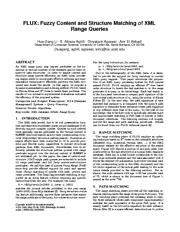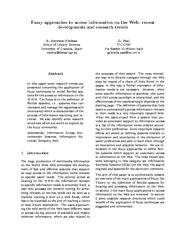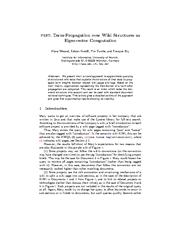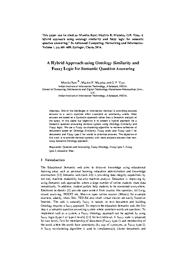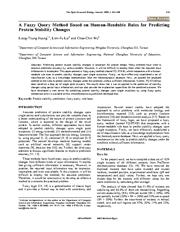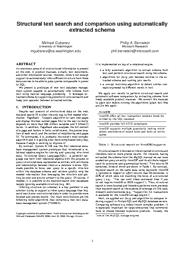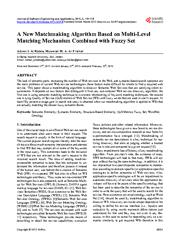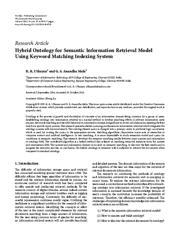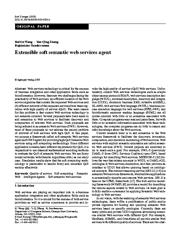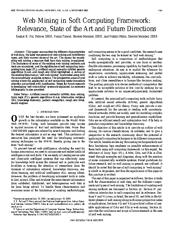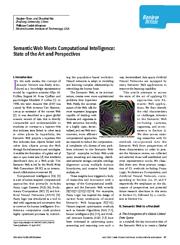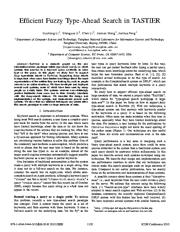A copy of this work was available on the public web and has been preserved in the Wayback Machine. The capture dates from 2017; you can also visit the original URL.
The file type is application/pdf.
Filters
In order to handle content and structure range queries efficiently, an XML query processing engine needs to incorporate effective indexing and summarization techniques to efficiently partition the XML ...
An XML range query may impose predicates on the numerical or textual contents of the elements and/or their respective path structures. ...
Due to the heterogeneity of the XML data, it is essential to provide the support for fuzzy matching in current XML query engines. ...
doi:10.1145/1135777.1136025
dblp:conf/www/LiAAA06
fatcat:6alubwtu6veoji2tl33lwbkthu
Fuzzy approaches to access information on the web: recent developments and research trends
2003
European Society for Fuzzy Logic and Technology
In this paper some research trends are presented concerning the application of fuzzy techniques to model flexible systems for the access to information on the WWW. ...
We also identify some research directions which are worth to explore by the fuzzy community. ...
In [15] and in [17] a survey of the main applications of Fuzzy Set Theory to data mining and Web mining can be found. ...
dblp:conf/eusflat/Herrera-ViedmaP03
fatcat:q4wugzf2efethf75jicu7f73l4
PEST: Term-Propagation over Wiki-Structures as Eigenvector Computation
2010
Semantic Wiki Workshop
We present pest, a novel approach to approximate querying of structured wiki data that exploits the structure of that data to propagate term weights between related wiki pages and tags. ...
However, in this case, documents that follow the convention are not necessarily ranked higher than other matching documents. (2) Some projects use the rich annotation and structuring mechanisms of a wiki ...
Acknowledgments The research leading to these results is part of the project "KiWi-Knowledge in a Wiki" and has received funding from the European Community's Seventh Framework Programme (FP7/2007-2013 ...
dblp:conf/semwiki/WeiandKFB10
fatcat:ivlqlz7g7neyjo3gljubjo6xcu
A Hybrid Approach using Ontology Similarity and Fuzzy Logic for Semantic Question Answering
[article]
2017
arXiv
pre-print
Most answers are based on a Syntactic approach rather than a Semantic analysis of the query. ...
We use a Fuzzy Co-clustering algorithm to retrieve the collection of documents based on Ontology Similarity. ...
Fuzzy co-clustering is used to retrieve the answers by matching user's question with the existing hierarchical ontology. ...
arXiv:1709.09214v2
fatcat:w3snfi2m3zg53lr2mwqxuayece
A Fuzzy Query Method Based on Human-Readable Rules for Predicting Protein Stability Changes
2009
The Open Structural Biology Journal
Further, FQ-STAB has been tested on a data set of single point mutants. ...
We have developed a web server for predicting protein stability changes upon single mutations by using fuzzy query mechanism and it is available at http: //bioinformatics.myweb.hinet.net/fqstab.htm. ...
FQ-STAB utilizes FuzzyCLIPS to deal with imprecision and uncertainty in fuzzy query and to offer the capability of fuzzy matching and fuzzy reasoning. ...
doi:10.2174/18741991008020100143
fatcat:to3faa727fgi3hlow3mb5aq7li
A Fuzzy Query Method Based on Human-Readable Rules for Predicting Protein Stability Changes
2009
The Open Structural Biology Journal
Further, FQ-STAB has been tested on a data set of single point mutants. ...
We have developed a web server for predicting protein stability changes upon single mutations by using fuzzy query mechanism and it is available at http: //bioinformatics.myweb.hinet.net/fqstab.htm. ...
FQ-STAB utilizes FuzzyCLIPS to deal with imprecision and uncertainty in fuzzy query and to offer the capability of fuzzy matching and fuzzy reasoning. ...
doi:10.2174/1874199100903020143
fatcat:7pbblqaauve6jkj2n5tpm3tfxm
Emerging Trends in Reducing Semantic Gap towards Multimedia Access: A Comprehensive Survey
2016
Indian Journal of Science and Technology
Objectives: The exponential growth of web has increased the volume of the documents. Data does not carry any meaning, but it should be interpreted efficiently for execution of query. ...
Semantic web is combined with statistical and machine learning techniques to increase the efficiency of an information retrieval system. ...
A fuzzy database is created and Neurofuzzy classifiers are applied to classify the regions of the images. Fuzzy structured query language is used. Also the accuracy rate is evaluated. ...
doi:10.17485/ijst/2016/v9i30/99072
fatcat:asnamx3urveabjyritsri3guuy
Structural text search and comparison using automatically extracted schema
2006
International Workshop on the Web and Databases
However, there is not enough support to automatically infer sufficient structure from these data sources to be able to pose queries comparable in power to SQL. ...
It leverages extracted schema by supporting powerful structural search and fuzzy join operator between extracted entities. ...
Therefore, we are able to support structural search, join as well as concept matching that are not available in either [17] , [12] or in [8] . [15] is an exhaustive survey of typical web data extraction ...
dblp:conf/webdb/GubanovB06
fatcat:27cf2bzq4zhzxpk6irogv6gsiy
A New Matchmaking Algorithm Based on Multi-Level Matching Mechanism Combined with Fuzzy Set
2012
Journal of Software Engineering and Applications
It depends on two factors that distinguish it from any conventional Web service discovery algorithm; the first one is using semantic matching technique to overcome shortcoming of keyword matching techniques ...
, the second one is tying Quality of Service (QoS) metrics of Web Service (WS) with fuzzy words that are used in user's request. ...
The first one is using multi-level matching mechanism through three categories of matching methods; structure-based matching technique, syntactic matching technique and semantic matching technique. ...
doi:10.4236/jsea.2012.53018
fatcat:6jhtpm6ojvabpkmszo7jafjwd4
Hybrid Ontology for Semantic Information Retrieval Model Using Keyword Matching Indexing System
2015
The Scientific World Journal
In text matching, it is more dependable to study semantics model and query for conditions of semantic matching. ...
In conclusion, the hybrid ontology in semantic web is sufficient to retrieve the documents when compared to standard ontology. ...
The Scientific World Journal 9 Furthermore, the hope of this research work motivates implementing fuzzy theory and neural network methods to build fuzzy ontology from unstructured data automatically. ...
doi:10.1155/2015/414910
pmid:25922851
pmcid:PMC4397492
fatcat:odn2nn5nvffr3jzb5fgsb7eoey
Extensible soft semantic web services agent
2005
Soft Computing - A Fusion of Foundations, Methodologies and Applications
Several proposals have been made to add semantics to Web services to facilitate discovery and composition of relevant Web services. ...
Such proposals are being referred to as semantic Web services (SWS). However, most of these proposals do not address the second problem of retrieval of web services with high QoS. ...
Acknowledgements The authors would like to appreciate the support by NIH under Grant P20 GM065762. We thank Dr. Harrison for his support and Mr. Tang for his valuable suggestions. ...
doi:10.1007/s00500-005-0029-3
fatcat:5zci4ydsdjeovdqcduq6k25q3q
Web mining in soft computing framework: relevance, state of the art and future directions
2002
IEEE Transactions on Neural Networks
This paper summarizes the different characteristics of web data, the basic components of web mining and its different types, and their current states of the art. ...
The limitations of some of the existing web mining methods and tools are enunciated, and the significance of soft computing (comprising fuzzy logic (FL), artificial neural networks (ANNs), genetic algorithms ...
or most suitable matches to a query unlike most existing search engines which display only the exact matches to a given query. ...
doi:10.1109/tnn.2002.1031947
pmid:18244512
fatcat:a2ea5nfnczgjlpwsbwe6ebt5hi
Chapter 12 Fuzzy data mining for the semantic web: Building XML mediator schemas
[chapter]
2006
Capturing Intelligence
Moreover, this information is interesting since it provides users with a semantic structure of the data they can query. ...
data on the Web. ...
Moreover, mediator schemas, fuzzy or not, can be used in the framework of fuzzy queries over web data. ...
doi:10.1016/s1574-9576(06)80014-6
fatcat:cggfk5so3bapxh2umfbxs4kivi
Semantic Web Meets Computational Intelligence: State of the Art and Perspectives [Review Article]
2012
IEEE Computational Intelligence Magazine
The work of the authors is funded by NSFC61070156, and national 863 program China Cloud Initiative. ...
Acknowledgments We thank all of our colleagues including Dr. Jeff Pan, Dr. Tong Yu, and Dr. Chunyin Zhou, for the fruitful discussion. ...
The vagueness and uncertainty may exist in user queries, in data content, in matching queries to data content, and in combining disparate data sources with overlapping ontologies. ...
doi:10.1109/mci.2012.2188592
fatcat:j7k3pfn2svaarjd7vwgmt3mkfu
Efficient fuzzy type-ahead search in TASTIER
2010
2010 IEEE 26th International Conference on Data Engineering (ICDE 2010)
We show that our efficient techniques can indeed allow this search paradigm to scale on large amounts of data. 1 ...
In this paper we study how to support fuzzy type-ahead search in TASTIER. ...
The Indexer component indexes the underlying data as a trie structure with inverted lists of keywords in the leaf nodes. We build a FastCGI module on the Web server to store the data and indices. ...
doi:10.1109/icde.2010.5447804
dblp:conf/icde/LiJLWF10
fatcat:soypddticrf3hjflfkxzjxcgya
« Previous
Showing results 1 — 15 out of 14,273 results

